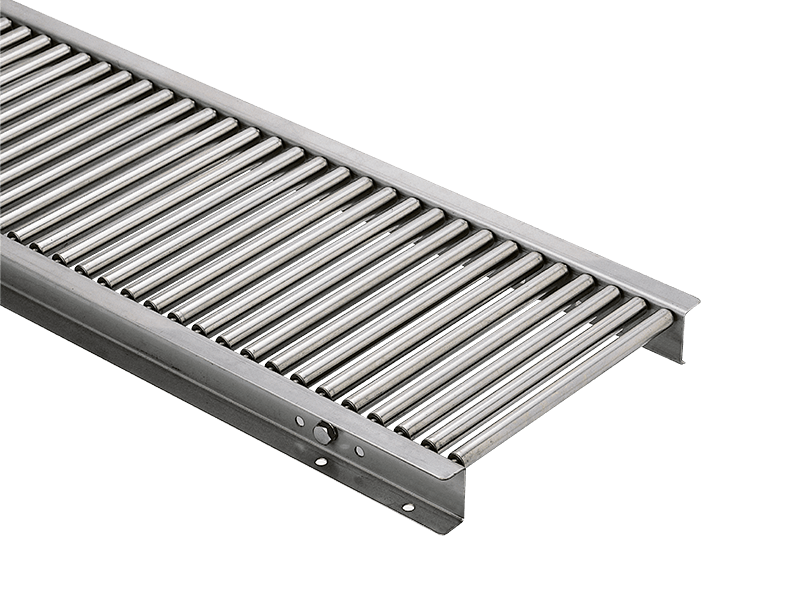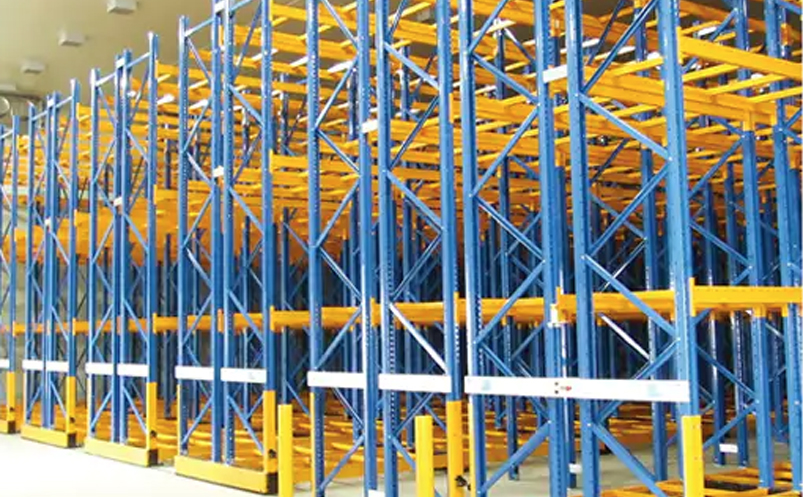In modern industrial environments, Stainless Steel Roller Conveyors play a vital role in ensuring smooth material handling, particularly in industries such as food processing, pharmaceuticals, packaging, and manufacturing. Known for their strength, corrosion resistance, and sanitary qualities, these conveyors are designed to operate reliably under demanding conditions. However, even the most robust system requires proper maintenance — especially when it comes to roller lubrication and upkeep.
1. Understanding the Role of Rollers in Stainless Steel Roller Conveyors
Rollers form the backbone of most conveyor systems. They support and move the belt or conveyed materials, ensuring smooth motion with minimal friction. In Stainless Steel Roller Conveyors, rollers are typically made from stainless steel grades such as 304 or 316, selected for their resistance to corrosion, wear, and chemical exposure.
However, even stainless steel rollers can experience frictional wear, buildup of contaminants, and bearing degradation over time. Without proper lubrication or cleaning, these issues can lead to higher energy consumption, increased noise, and eventual mechanical failure. Therefore, roller lubrication and maintenance are not optional—they are essential to sustaining reliable conveyor operation.
2. Why Lubrication Matters in Stainless Steel Roller Systems
Although stainless steel is known for its self-sustaining durability, the moving parts inside roller assemblies—particularly bearings and shafts—still require lubrication. Here’s why lubrication is crucial:
- Reduces friction: Proper lubrication minimizes metal-to-metal contact, allowing rollers to rotate smoothly.
- Prevents wear: It reduces bearing and shaft wear, extending component life.
- Prevents corrosion: In humid or chemically active environments, lubrication acts as a barrier against moisture and contaminants.
- Enhances energy efficiency: Well-lubricated rollers require less torque to operate, lowering power consumption.
- Reduces noise: Smooth rotation reduces operational noise, which can be significant in large conveyor installations.
In short, lubrication ensures that the conveyor continues to run efficiently while avoiding costly breakdowns.
3. Types of Lubrication Used in Stainless Steel Conveyor Rollers
Not all lubricants are suitable for Stainless Steel Roller Conveyors, especially in industries where hygiene and contamination control are paramount. The type of lubricant depends on the application, environment, and regulatory requirements. Common types include:
a. Food-Grade Lubricants
Used in food processing, pharmaceuticals, and packaging industries, NSF H1-certified lubricants are formulated to be safe in incidental contact with food. They are often synthetic and resistant to washout from cleaning procedures.
b. High-Temperature Lubricants
For conveyors operating near ovens or in heat-intensive areas, high-temperature lubricants (such as synthetic oils with PTFE additives) ensure stability without degrading or carbonizing under thermal stress.
c. Corrosion-Resistant Lubricants
These contain anti-rust and anti-oxidation additives to protect roller bearings and shafts in humid, chemical, or outdoor environments.
d. Dry Film Lubricants
In environments where oil or grease could attract dust, dry film lubricants (e.g., molybdenum disulfide or graphite-based) provide low-friction coatings that do not accumulate contaminants.
e. Self-Lubricating Bearings
Some Stainless Steel Roller Conveyors use sealed-for-life or self-lubricating bearings, eliminating the need for regular re-lubrication. These bearings contain pre-applied lubricants within a sealed unit, ideal for applications where frequent maintenance access is limited.
4. Lubrication Methods and Procedures
The lubrication method depends on the conveyor’s design, operating conditions, and maintenance accessibility. Below are common methods used across industries:
a. Manual Lubrication
Maintenance personnel apply lubricants manually using grease guns or oilers. This method is cost-effective but requires scheduled attention. Care must be taken to avoid over-lubrication, which can cause spillage and attract contaminants.
b. Automatic Lubrication Systems
For continuous or hard-to-reach conveyor systems, automatic lubrication units deliver precise lubricant amounts at set intervals. These systems enhance consistency, reduce labor, and prevent both under- and over-lubrication.
c. Centralized Lubrication
Multiple lubrication points are connected to a single reservoir and pump. Maintenance teams can lubricate all rollers from a central station, saving time and improving efficiency in large installations.
d. Bearing-Specific Lubrication
In sealed bearing rollers, lubrication access points are minimized. Maintenance may involve periodic inspection and replacement rather than active lubrication, ensuring cleanliness and reliability.

5. Cleaning and Maintenance Practices for Stainless Steel Rollers
Lubrication is only part of the maintenance process. Cleaning, inspection, and preventive care are equally vital to sustain performance. Here’s how maintenance is typically carried out:
a. Regular Cleaning
Dust, product residue, or chemical buildup can hinder roller performance. For Stainless Steel Roller Conveyors, cleaning usually involves:
- Warm water and mild detergent to remove debris.
- Non-abrasive brushes or cloths to avoid scratching.
- Food-grade disinfectants in hygienic environments.
High-pressure or steam cleaning may also be used, but it’s essential to re-lubricate bearings afterward since moisture can wash away protective oils.
b. Inspection and Alignment
Rollers should be inspected for:
- Misalignment or uneven wear.
- Excessive vibration or noise.
- Bearing play or stiffness.
- Signs of corrosion or contamination.
Routine alignment checks prevent belt tracking issues and uneven load distribution, both of which can accelerate wear.
c. Bearing Replacement
Bearings are typically the first components to degrade. Regular vibration monitoring can help detect bearing wear before failure occurs. Replacing bearings proactively reduces downtime and protects the overall conveyor system.
d. Tension and Load Management
Overloaded conveyors place excess strain on rollers and bearings. Periodic verification of load capacity and belt tension helps maintain optimal performance and extends component life.
6. Maintenance Scheduling and Record Keeping
Effective maintenance requires planning. A structured schedule should outline lubrication intervals, inspection routines, and part replacements. A common approach is to use a Preventive Maintenance (PM) program, which might include:
- Daily: Visual inspection and cleaning of visible rollers.
- Weekly: Check roller rotation smoothness and alignment.
- Monthly: Inspect lubrication points and apply lubricant as needed.
- Quarterly or semi-annually: Deep cleaning, bearing checks, and replacement of worn components.
Digital maintenance logs or computerized maintenance management systems (CMMS) can track performance trends, making it easier to predict issues before they escalate.
7. Common Mistakes in Roller Maintenance
Even well-intentioned maintenance can go wrong if best practices are not followed. Some common errors include:
- Over-lubrication: Excess grease can attract dirt, causing abrasive wear.
- Using incompatible lubricants: Non-food-grade or chemically reactive lubricants may damage seals or contaminate products.
- Neglecting re-lubrication after cleaning: Cleaning solvents can strip away protective oils, leaving bearings vulnerable.
- Ignoring early warning signs: Unusual noise, vibration, or uneven belt movement often signal impending roller failure.
- Lack of documentation: Without proper records, it’s difficult to ensure consistent maintenance routines.
Avoiding these mistakes not only enhances reliability but also reduces repair costs over time.
8. Emerging Trends in Roller Maintenance
Recent innovations are helping companies maintain conveyors more efficiently:
- Self-cleaning rollers that prevent buildup of debris.
- Smart bearings equipped with sensors to monitor temperature, vibration, and lubrication levels.
- Eco-friendly lubricants that minimize environmental impact without compromising performance.
- Maintenance-free roller designs that use sealed systems or advanced materials like polymer-coated bearings.
These advancements aim to minimize downtime, labor, and waste—key goals in modern production lines.
9. Conclusion
Proper lubrication and maintenance of stainless steel conveyor rollers are essential to ensure smooth operation, product quality, and long-term reliability. Even though stainless steel resists corrosion and wear, its moving parts still depend on careful upkeep to perform at their best.
By selecting the right lubricant, applying it correctly, cleaning regularly, and monitoring roller performance, operators can significantly extend the lifespan of their conveyors. In doing so, they not only prevent costly downtime but also maintain the efficiency and safety that stainless steel conveyor systems are known for.
In essence, a well-maintained roller system is the foundation of a dependable conveyor — and by extension, a productive, efficient, and trouble-free operation.







